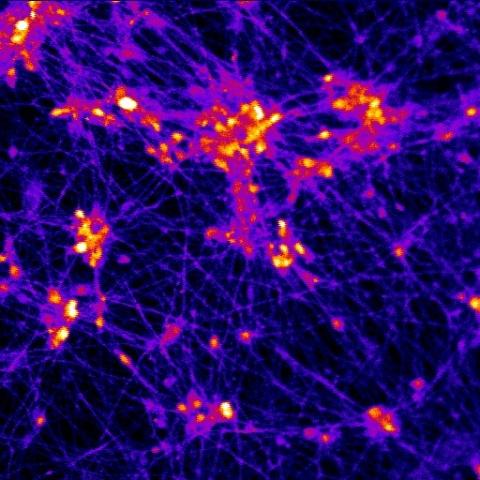
This May, members of the Duke Neurology Department contributed to 12 new peer-reviewed journal articles. Highlights of this research include the first study to examine trauma-associated sleep disorder among U.S. veterans, the development of a highly sensitive microscopic technique to identify the regions in the brain where seizures begin, and a small but innovative trial showing early promise for a potential alternative therapy for amyotrophic lateral sclerosis (ALS).
Read about these and other recent publications, and find links to the original research articles themselves, in the paragraphs below.
Epilepsy, Sleep, and Clinical Neurophysiology
- Ann Augustine, MD, was the senior author of the first study to examine the prevalence of trauma-associated sleep disorder (TASD) among U.S. veterans. The analysis of nearly 4,000 veterans found nearly 1 in 8 (12.1%) had TASD, with those afflicted with TASD being close to 4 times more likely to have posttraumatic stress disorder and depressive disorder. Read the full study in Sleep Advances.
Memory Disorders
- Recent research has found racial and ethnic variations in the associations between the apolipoprotein ɛ4 (APOE ɛ4) allele and the risk of developing Alzheimer’s disease and related dementias. Kathie Welsh Bohmer, PhD, was part of a team that examined associations between the APOE ɛ4 allele and the risk of developing dementia in global Hispanic populations from different ethnic regions of origin. They found associations between APOE ɛ4 and increased ADRD risk for South American populations, with the potential for additional environmental or genetic risk factors associated with ethnic variations. Read the full article in the Journal of Alzheimer’s Disease.
- James Burke, MD, and Brenda Plassman, PhD, contributed to a new study that examines the connections between depression and cognitive impairment. Burke, Plassman, and colleagues examined associations between elevated β-amyloid levels, depressive symptoms, and diagnosis of depression in a group of Medicare beneficiaries with cognitive impairment. Read what they found in the Journal of Affective Disorders.
- Brenda Plassman, PhD, also contributed to a new systematic review and meta-analysis examining associations between traumatic brain injury (TBI) and future dementia. The examination of three decades of academic literature found that TBI was associated with a nearly 70% increased risk of dementia, with higher risks associated among younger adults, men, and populations in Asia. Read the full article in the Journal of Neurotrauma.
Neuromuscular Disease
- A new study in Muscle and Nerve answers important questions about myasthenia gravis with muscle-specific tyrosine kinase antibodies (MMG) and its effects on maternal and fetal health. Senior authors Yohei Harada, MD, and Janice Massey, MD, as well as Vern Juel, MD, Lisa Hobson-Webb, MD, Shruti Raja, MD, and Don Sanders, MD, performed a retrospective review of MMG patients before or during pregnancy from 2003 to 2022. Read their findings here.
- A new open-label trial for clenbuterol shows the beta-agonist has potential as a treatment for amyotrophic lateral sclerosis (ALS). Senior authors Xiaoyan Li, MD, and Rick Bedlack, MD, PhD, conducted a small trial of 25 participants with ALS, finding the treatment was safe and associated with slowed disease progression. Michael Lutz, PhD, also contributed to the study, which appears in the Journal of Clinical Neuromuscular Disease.
- Identifying effective therapies for amyotrophic lateral sclerosis (ALS) requires valid and responsive outcome measures to track disease progression and therapeutic gains for clinical trials. Rick Bedlack, MD, PhD, contributed to the Amyotrophic Lateral Sclerosis-Health Index (ALS-HI), a multifaceted, disease-specific patient-reported outcome measure (PRO) designed to address this need by measuring ALS symptomatic disease burden in adults with ALS. Read more about the ALS-HI and its development in Amyotroph Lateral Scler Frontotemporal Degener.
- Neuromuscular ultrasound has become an integral part of the diagnostic workup of neuromuscular disorders at many centers. Unfortunately, uniform standard scanning techniques do not currently exist for this technique. Lisa Hobson-Webb, MD, was part of an expert panel offering a set of protocols to serve as references for clinicians and researchers. Read those protocols in Muscle and Nerve.
Stroke and Vascular Neurology
- Brian Mac Grory, MB BCh, MRCP, was part of a new study that examined whether faster intravenous thrombolytic therapy (IVT) translates into better long-term functional outcomes for acute ischemic stroke patients treated with endovascular thrombectomy (EVT). The study found that each 15-minute increase in door-to-needle times was associated with higher odds of long-term hospital care, increased mortality, and other measures. Read the full study in the latest issue of Circulation.
- Brian Mac Grory, MB BCh, MRCP, also contributed to a new systematic review examining whether borderzone infarcts that occur after intracranial arterial stenosis-related stroke (ICAS). The team’s analysis suggests that borderzone infarcts occurring secondary to ICAS are a potential imaging biomarker that predicts neurological deterioration and/or stroke recurrence. Read the full article in the Journal of Stroke.
Translational Brain Sciences
- Tatiana Segura, PhD, was the senior author of a study that examined the change in M1/M2 polarization when macrophages were confined in microporous annealed particle scaffolds (MAP), which are granular hydrogels generated from annealed spherical microgels. Read what that team found in the latest issue of Advanced Healthcare Materials.
- Greg Cogan, PhD, Derek Southwell, MD, PhD, and colleagues at Duke Neurosurgery were part of a team that used high-resolution thin-film microcontact surface arrays to capture microscale high frequency oscillations, which act as potential biomarkers of the epileptogenic zone. Read their full article in Epilepsia.